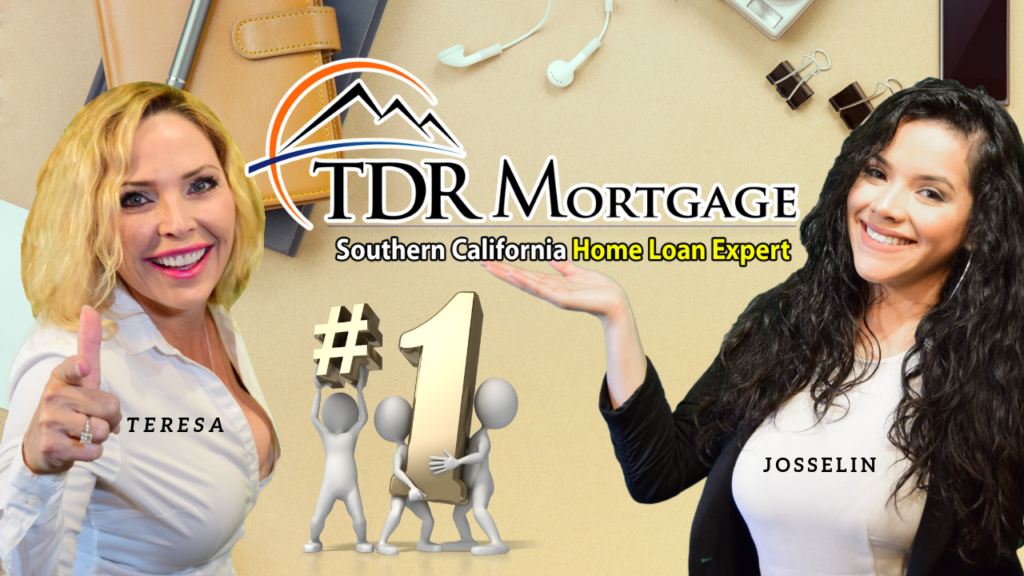 Joss and I went to a home buyer program update etc. and we are going to share some NUGS, who doesn’t like a good Nug now and then?
Joss and I went to a home buyer program update etc. and we are going to share some NUGS, who doesn’t like a good Nug now and then?
Topics Include the following take away;
CalHFA (down payment assistance)
Low MI on 3% Conventional regardless of FICO score
Ways to get in with 3-5K on a 350-500k house
4% Silent 2nd Teacher Programs
Platinum Program (down payment assistance)
When it makes sense
How you can get 5% FREEEEEE money on a home purchase FREEEE did you hear me, i said FREEEEE (Service Professionals, Safety Teachers etc. ) High rate but wait 6 months and refi.
More free money if you qualify for the Freddie Mac Grant (1500-2500)
Ready Nest (buy now VS Rent calculator)
1st Time Home Buyer program update 2019
Best CA Mortgage Broker
Hi, my name is Teresa Tims. I’m president of TDR Mortgage. My partner is one of our lenders that we partner with, Mountain West Financial, put on a 1st time Home Buyers Seminar. Basically, in order to maintain the utmost value and utmost current opportunities in lending, we’re constantly going and educating ourselves on the programs. So, I like to stay cutting edge on things that are out there and even sometimes when you know a program. Having refreshers throughout the year are a very good investment of time and so, prior to that class. I think Josselin, you hadn’t been to one of those with me before, huh?
Whenever you do a regular loan, there are intricacies in regular home loan financing. That you have to beware of, but then when you layer a program onto an FHA loan or a conventional loan. It adds a pretty heavy layer of additional things that you have to look out for. When you’re a loan originator and you send somebody out to go write offers. The last thing that you want is to send a buyer out with a pre-approval for 400 thousand.
And have the agent go work nights and weekends, get ’em an for a couple weeks. Later after spending 40 hours of drive time out in the field and then because, as a loan officer, you miss something and an update. You didn’t quite calculate the income correctly and they don’t qualify because of income or a variety of other reasons. It can be pretty detrimental to the confidence of the realtor partner that’s spending their time out in the field and also to the client. So, we’re highly motivated by staying cutting edge and CalHFA.
CalHFA. Yeah, we learned that. CalHFA is one of the oldest programs. Tried and true programs, that I’ve been doing since 1998 and so today. We just kind of wanted to talk about our takeaways from that class. So, I want to start with CalHFA, which is the California Housing and Finance Authority down payment assistance. Down payment assistance programs are driven largely by two main factors, income and debt to income ratio qualifying. On buyer programs, the maximum that you can usually go, or any of the programs that I know, are 45 debt ratio. Whereas FHA, you can go to a 56 back in and that means normally, on a normal loan. They’d qualify to 400 thousand, but because of the 45 debt ratio, they’re limited to 325. And so that’s one of the biggest pitfalls and why most people choose to not use a buyer program.
So, I think, my takeaway was just a gentle reminder about the conventional loans and the low MI that’s afforded to someone going through the CalHFA program. And getting a CalHFA first and then a CalHFA second and third, that on an MI loan. A regular conventional loan, where they’re putting 3% down. If they’ve got a 6/60 score or maybe even 6/80, the MI is so high. It makes no sense for them to seek out conventional financing.
So when you are looking for some buyer program like regular FHA, 3% regular conventional without the CalHFA program. You’re going to need 3% plus you’re closing cost, but you have this opportunity through the CalHFA program to get a second, do a regular. Not a regular, but a CalHFA 3% first and then go in and get that second. For teachers, right? there’s a new program for teachers, they can get the second for up to 4% to the closing cost so you really only need. So, I thought that was really cool, that I learned from the class, that I didn’t know was available or that was even a thing. I always thought that it was the CalHFA first, the second and the third.
Okay. Well, cool. The teacher one is kind of an obscure one and that was a good refresher for us because we, when talking to the teachers, especially that demographic usually has a pretty secure job, they oftentimes have a little bit of money, but on a 3% conventional teacher loan, you would need like 24, 25 thousand dollars and a lot of teachers, especially just starting out, they often don’t have that big chunk of cash. So, with this teacher program, we did a little thing. We did a lot of things. It gets really complex because here, I’m just going to show this. So, what do you have for a 400 thousand dollar sales price? What is the total monthly PITI payment?
With the CalHFA, you’re looking at $3253 monthly payment. Okay. $3253. That includes taxes and insurance. Principal, interest, tax and insurance. And what is the interest rate on that loan? Okay, 5%. Now you, also, on a 6/40 credit score, you price that loan out with a regular conventional loan and that rate was 5.25 and the mortgage insurance is $407 a month, which that’s a big chunk and with the CalFHA, it’s 5% and you do get a little discount on that MI.
Now, if you look right here though, if you have a 7/60 or 7/40 score, look how low that mortgage insurance drops. You could save like $300 doing that. So, here in this scenario where we’ve got this $3253, you could very well have your payment around $3000. Conversely, getting in a conventional loan with 3% down, you need 24 thousand dollars.
 Josselin put together a little sheet, where with the CalHFA program, you can get some down payment assistance and only need about 15 thousand dollars. I wish there was a way we could write it out but I thought this would be the easiest thing to do so you could see that. So, you need 15 thousand dollars and we could even get maybe five thousand dollars or seven thousand dollars of seller concessions to get a teacher in with seven or eight grand.
Josselin put together a little sheet, where with the CalHFA program, you can get some down payment assistance and only need about 15 thousand dollars. I wish there was a way we could write it out but I thought this would be the easiest thing to do so you could see that. So, you need 15 thousand dollars and we could even get maybe five thousand dollars or seven thousand dollars of seller concessions to get a teacher in with seven or eight grand.
So, I think, breaking it down, we have a little bit more work to do with the MI calculations. MI is very tricky because it goes off of a sliding scale. So, when you’re using a down payment assistance, or regular, it goes off of a sliding scale. With the down payment assistance programs, it’s much more generous and giving you that lower rate. We did this thing but it’s kind of going to be hard to see, huh? Yeah, it’s really small.
So, this is the one where, if they have a 760 FICO, it’s $94 versus $367 and this is CalHFA too, right? It should be, yeah.
CalHFA. Look at her correcting me. Let me circle that here. So, this is the 94. That’s really a big difference. So, usually you find that with conventional programs, here with the lower score and then here with the higher score, $94. So, it’s a pretty big bang for your buck and who doesn’t love a big bang for your buck, right? Okay. So, I think that’s my CalHFA stuff. CalHFA’s pretty basic. Oftentimes, the CalHFA program-
CalHFA. Whenever we get a buyer in, we intake a buyer and we say, ‘Okay, look. This is what it looks like Conventional, FHA, Buyer Program.’ So, we’re presenting all the options and educating the buyer on all the options and typically, what does that look like, Josselin, when you’re going through an exercise like that?
So, today, right? I had a client call, they were referred to us by an agent and they were working with another lender and they were looking for a down payment assistant program or a first time buyer program. So, I went over the difference with FHA and CalHFA. So, FHA, we are mortgage brokers so we get a wholesale rate.
The difference is we’re a mortgage broker firm so we get wholesale rates. With FHA, the great thing about that is we can work with the rate to give you closing cost credit in your rate to cover your closing cost. The most of the time, you only need your down payment. This couple, they’re looking at 300 thousand dollar houses, right? They have eight thousand dollars in the bank right now.
If they were to do regular FHA, and they have really good credit scores, so we could cover all their closing costs and they only need 12 thousand dollars to put down, right? But they could also do the CalHFA with a first, second and a third, and come in with zero money, right? Their payment would be a little bit higher with the CalHFA program because the CalHFA FHA rates are higher.
CalHFA, FHA rate. Are higher than your regular FHA rates. So, I went through that with them and what happens most of the time is they’re like, ‘Okay, I can get in with no money. Which is great, they get to save their eight thousand dollars, but now they have a second and a third, which-
I think, too, the big thing is 3.75 versus 5, and CalHFA just did a rate reduction. It was like five and a half or five and three quarters. So now, 5% or five and a quarter, versus 3.75, I don’t know about you but 3.75 is way sexier than 5% and I think most borrowers, they try to figure out a way to come up with the money and in this instance.
Yeah. So, he was like, okay, you know what? They have a few months to move out of their place so he’s like, I know that I can come up with the extra money I need to get the regular FHA to have the lower payment and not have to owe extra money and then owe so much and then my equity is in jeopardy.
Which was his big thing, which is a really smart thing to do but for those people that are really good with their finances and they have a really good job and they can qualify for a 400 thousand dollar house and they don’t mind the $3500 payment with CalFHA ’cause they don’t need any money to put down, that makes sense, ’cause you just want to own a home and you know you can afford it but you can’t save the money, then yeah, do the CalHFA.
Well, there’s a huge value in home ownership. So, don’t let the fact that we have some people say, ‘I don’t want to do a buyer program ’cause I’m going to owe 20 grand.’ Yeah, but in three years, your equity is going to be 60 grand. So, you just lost out on the opportunity of 40 thousand dollars in equity, you lost out on the opportunity of write offs and you lost out on the opportunity to build and grow wealth and you build and grow wealth primarily through real estate ownership.
And so, what we try to do is educate you on all the fine intricacies of, that’s really important and, not only that, I don’t know about you but rent keeps going up and so, you’re going to be leveraging yourself with this $3000 payment and it’s not going to keep going up, with the exception of your taxes and insurance because the taxes do go up every year, etc. So, I think that’s a really good point that you brought up and a practical exercise in what makes sense for you and when you come to us and we go through all the steps, you have so much education. You’re able to make your own decision.
And it’s weird because today, I had old clients come in and I got two new pre-quals over the phone and the one thing that they all told me is, ‘I really like that you guys explain and really narrow everything down.’ The two pre-quals that I got are working with other people that are not explaining the options that they have, one, and two, they’re not getting back to them, which is ridiculous.
Well, yeah. I think, a lot of times in our industry, just like a lot of industries, if you’re not cutting edge and you don’t understand things yourself, you’re not going to be able to explain it and make it simple and, really, you don’t have to make all your money on one loan. You’re gonna do one loan for this person and then you’re going to do their refinance, you’re gonna do their move up purchase, you’re gonna do loans for their family. So, there’s a big value in taking care of people at that initial onset of the meeting.
Okay. So, that’s CalHFA. Okay. So, this one program, Platinum Program, I don’t really like it. So, every time I look at it, they were talking about it, I’m like, ‘Oh, the Platinum. It’s so stupid. Oh, my God. It’s like 6% rate, 5.5% rate.’ And 6%, that’s super high. So, when we look at programs that don’t make sense, it’s pretty easy to, I don’t wanna say sell against it, but find reasons why we’re not even presenting that program because it makes no sense.
So, when you come to us, there’s a lot of stuff we’ve already evaluated and ruled out that you may not even know that we ruled out, just because it makes no sense for you, for the most part. But this Platinum Program, it was a refresher on how it does make sense. Do you recall how it makes sense?
The thing that really stuck out to me the most was that you’re getting a grant and in two years was it two years or three years? You don’t have to pay it back, as long as you still live in the property. So, versus the CalHFA, if you are selling me a house or if I’m buying a house, and I know I can get this grant that I know I’m going to live in this house for at least two years and then I don’t have to pay that grant back, that’s why not do it?
Hey, everybody, sign me up. I’ll take two.
Okay. So, the Platinum Program. Where I would find a value in recommending this program would be if you’re in the health and safety field, minus being a nurse. So, a police office, firefighter, teacher, and there’s a whole of professionals that fall into that category, you would, again, buy this 500 thousand dollar house. You could do a 3% down conventional program, low MI, 400 thousand dollars, you’d get 5%. So, that’s like 20 grand. 20 gs. So, you know what?
Maybe you’re right. A 6%, 5.5%. So, we get you this money the day after the loan closes. You don’t pay that back. It’s free money. It’s 20 thousand dollars of free money, 400 thousand dollar purchase price. You can go higher, depending on your qualifying. Remember, 45 debt ratio so you’re going to be limited and restricted to that, but the day after it closes, you are relieved from paying that back, unlike the CalHFA that you do pay that back.
It’s low interest but you do pay it back. And then, six months later, you can refinance with no harm, no foul, no penalty. So, when I looked at that, I’m gonna do its own video and break that out and really market that to the professions that applies to. But, to me, that was super huge takeaway. What were your thoughts on that? Free money.
Yeah, it’s free money. I don’t have to pay it back as long as I live in the property for two. That makes sense to me.
So, no, on the teacher one, if you’re the qualifying professional, there’s really no restriction. Anytime you buy a house, you buy it with the intent that you’re going to live there. Oh, you do have to live there three years, or you have the recapture thing. Oh, you’re right. Look at you.
So then, what about if you got that money and you live there three years? Let’s say you’re not a teacher, you’re just a Joe Bloe and you. I don’t know. Whatever your profession is.
Well, there was something about the teachers that I didn’t pay attention to.
So, we will get more information but, for the most part, it’s free money. So, we will narrow it down.
Yeah. So, always, when you layer something over a regular loan, you’re bringing in an additional complexity issue that you really need to sit down and break it out and understand it and make sure that you’re delivering this expectation that you can close on ’cause it would really suck. Oh, hey, it’s free money, but then it’s really not. No, that wouldn’t happen when you come to TDR Mortgage. We would not do that to you.
Mortgage Credit Certificate Program (MCC)
We got you. Okay. I didn’t even mention the MCC thing, huh? ‘Cause we did that was a thing.
It was kind of dumb when we looked into it and we’re good at dissecting and throwing out what we don’t need.
Okay. So, Mortgage Credit Certificate Program. I’ve been doing loans since 1998 and every time I get started in down the path of doing the Mortgage Credit Certificate Program, I think it all sounds great, let’s do it, and then when you really dive in deep, it’s not applicable on a lot of levels.
What I will say though, is that through Mountain West Financial, the Mortgage Credit Certificate Program. I have a client right now that we’re working on and we can only get them to 337 and it’s because of student loans. These darn student loans, now when people go to school, you have 60, 70, 80 thousand dollars of student debt is not uncommon and if on the credit report, you’ve bought a $9000 loan and you’re paying $15. Tell me about that, Josselin. Why does that not work?
It doesn’t work for FHA because FHA wants to make sure that you are paying your debt down.
Yeah, you’re going to pay it off. But the way that these student loan companies do it is they do it based off of their calculations and you’re not really paying towards your principal, pretty much. So, it’s not amortizing. You’re never going pay it down.
So, when you say amortizing, tell me specifically what you mean. If you got this $8000 debt and you’re paying $15 a month and every year, you’re adding to that balance.
So, the way they want to see it is, how much time do you have left in your loan times whatever you’re paying, will that pay that debt off?
In a certain period of time.
Like 10 years, 20 years, 30 years.
Right. If you have 10 years left and with making that payment, you’re going to pay that debt off, then they’re fine with it. But if you have 10 years, five years left, and you’re only paying $15, you’re not going to be able to pay $8000 off. So, that’s how they calculate it.
And that’s FHA.
Tell me how conventional. FHA, 56.7, 56.9 debt ratio, which the qualifying is 325 versus a 45 back end at 400. So, on conventional.
So, on conventional, they will go based off of whatever is in your credit. Now you’re limited to how much you’ll qualify for and the rate is higher and you need more money ’cause we can’t cover your closing cost.
Yeah. Then you’re like, okay, let me go put back on my thinking cap. This MCC Program, one of the things about it, it’s a Mortgage Credit Certificate Program that gives you an additional tax credit at the end of the year. So, my people that qualified for 337, I was like, ‘Oh, I could get them, if they buy in County, I could get them an extra.’ There’s a calculation of formula. I can get them an extra 225 of income from that $3000 annual savings that they’re going to get. So, I’m like, oh, my God. I’m a genius.’ And I’m texting my processor, ‘Terry, let’s rerun it and calculate it with the extra $225 income.’ And so then, she’s like, ‘Yeah, but what about this? What about that?’
Yeah, she said, ‘Hold up.’ Let’s read the guidelines right and get it correctly.
And so what happened in that scenario?
So, there’s limitations for county, and per income. So, if you have two borrowers that make over the income, then they can’t qualify for the program. Because with just an extra $250 in income, I’d already had it. I was like, ‘Okay, you guys qualify for 360, let’s rock ‘n roll. You can find a place for 360.’ 337, you could do it still. If I only qualify for 337, I will find a house. I will buy a house and I would have a place and I would have a tax write off and I would have equity gains and I would be creating wealth. I would not limit myself on sales price, especially if I was out in this area. Yeah, maybe if I worked out in Irvine, I probably wouldn’t buy in Reno Valley. I probably wouldn’t.
I need a life. And then, so then I was like, ‘Okay, cool. So, we can do it in but then what about LA, Orange, and well, Orange is not really applicable, LA’s not really applicable because the income limits are so restrictive, but then Riverside has it but then you have to get it approved with Riverside and so again, that’s why we’re just like, oh, MCC are stupid.
Yeah.
But it is going to be like an ace in the hole. I’m going to go and check out the Riverside MCC Program, get approved. Just that extra bit of qualifying, if that is make it or break it and getting somebody to that next level where they really want to be and really want to buy, then I’m going figure out a way to do it.
And then, too, yeah, that was with this client, but maybe we have a client that is within the income limits so now we know we can give you that extra money. So, you never know.
You never know. So, that’s my takeaways. Do you have any other takeaways?
No, that’s it.
 Okay. So, if you’re looking to buy or sell in Southern California, what should they do?
Okay. So, if you’re looking to buy or sell in Southern California, what should they do?
You need to pick up that phone and give us a call at 909-920-3500 because we will give you the best option for you.
Check us out on the web TheSoCalLoanPro.com





 Teresa Tims is President of TDR Mortgage in Charming Downtown Upland CA. She prides herself in offering quality home loan products, competitive pricing and knowledgeable assistance when helping her clients select a home loan. Teresa is a life-long resident of the Inland Empire.
Teresa Tims is President of TDR Mortgage in Charming Downtown Upland CA. She prides herself in offering quality home loan products, competitive pricing and knowledgeable assistance when helping her clients select a home loan. Teresa is a life-long resident of the Inland Empire.